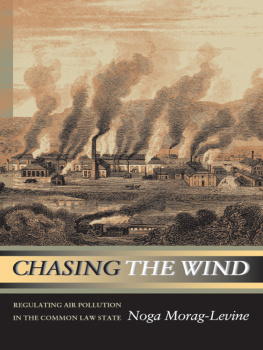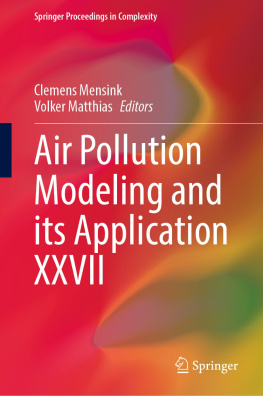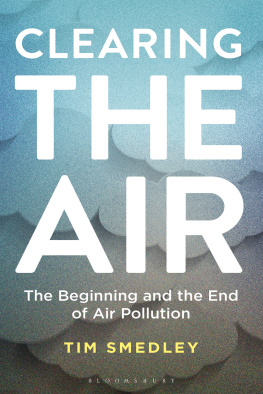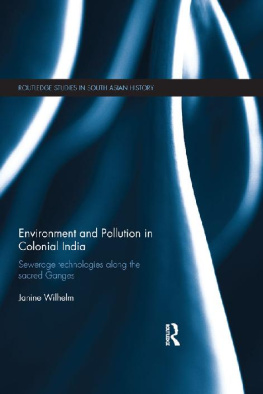Chasing the Wind
Chasing the Wind
REGULATINGAIRPOLLUTIONIN
THE COMMON LAW STATE
Noga Morag-Levine
PRINCETON UNIVERSITY PRESS
PRINCETON AND OXFORD
Copyright 2003 by Princeton University Press
Published by Princeton University Press, 41 William Street, Princeton, NewJersey 08540
In the United Kingdom: Princeton University Press,
3 Market Place, Woodstock, Oxfordshire OX20 1SY
All Rights Reserved.
Library of Congress Cataloging-in-Publication Data
Morag-Levine, Noga.
Chasing the wind : regulating air pollution in the common law state /
Noga Morag-Levine.
p. cm.
Includes bibliographical references and index.
eISBN: 978-1-40082-585-1
1. AirPollutionLawand legislationUnited States. I. Title.
KF3812.M67 2003
344.73046342dc212002035552
British Library Catalog-in-Publication Data is available
This book has been composed in Postscript Sabon Typeface Printed on acid-free paper.
www.pupress.princeton.edu
Printed in the United States of America
10987654321
TO THE MEMORY OF MY FATHER,
Amotz Morag
Contents
Preface
TO MOST READERS of this book, localized air pollution concentrations, or hotspots, are familiar only as momentary waves of caustic fumes encountered while driving past refineries, steel mills, chemical manufacturers, pulp mills, or other heavy industrial sites. But for the millions of Americans who live in close proximity to these pollution sources, such fumes are a constant intrusion and a persistent source of worry. Noxious vapours was the Victorian term for these gases and their multiple sensory assaults. Since the beginning of industrialization, some of those exposed to these vapors have attributed to them a long and consistent set of symptoms and concernsnausea, vomiting, headaches, stinging throats, constricted chests, burning eyes, and a vague but persistent concern about longterm health effects. The seed of this book was such a worry.
Soon after moving into an Albany, California, apartment, my family noticed the intermittent presence of burnt plastic-like fumes that left an irritating, caustic sensation in the eyes and nose, and a bitter taste in the mouth. The fumes would come and go with the wind, and vary in their intensity. The parents of two young children, my husband and I soon became concerned that the air might be harmful, and we began to inquire as to the fumes source. After a number of false starts, we were referred to the regional air pollution agency, the Bay Area Air Quality Management District (BAAQMD) and contacted its complaint hotline. The agency registered our complaint under odors and sent an inspector, who informed us that the fumes came from a steel foundry located less than a mile away. The fumes were created by the rapid heating of synthetic resins during the metal-casting process, andas we would later learnincluded the emission of benzene, phenol, formaldehyde, and other hazardous air pollutants. We were told that for the Air District to take action, it must first establish that the odor amounted to a public nuisance. Under district rules, this required, as a first step, that complaints from five separate households be confirmed within a twenty-four hour period.
Encouraged by the prospect of pollution abatement, we began to call and register complaints. Although the agency responded diligently to each such complaint, we found that we often were unable to have our complaints confirmed. In the interval between our phone call and the arrival of the inspector, the odor often disappeared as a result of shifts in wind direction or in the foundrys production processes. The inspector would arrive and sniff the air but neither she nor I could detect any trace of the smell. Apologetic and somewhat embarrassed, I would try to explain that the fumes were evident one, two, or three hours earlier when I called. Sometimes inspectors would even indicate that they had perceived the smell on the way over or even in our parking lot, but without detecting it in our presence, they could record no confirmation. Though we failed to confirm most of our complaints, on occasion luck was on our side and the odor lingered until the moment at which the inspector knocked on our door. Even our hardwon successes in confirmation did not usually trigger action, because five separate confirmations during a twenty-four hour period were required before the Air District would issue a citation to the foundry. Irrespective of the number of days in which two, three, or four complaints were confirmed, with each twenty-four hour period the counting started afresh.
The inspectors seemed to be fair-minded and conscientious people who were referees for a game whose rules were unambiguous in their implementation but inexplicable in their logic. Puzzled, and increasingly frustrated, we began to hear about many others who had shared our experience. We also learned that for several years prior, residents in adjacent neighborhoods had actively mobilized against the fumes. Their efforts had led to the installation of partial fume controls on one of the foundrys three local plants, but left fumes on the remaining two plants uncontrolled. Yet the Air District continued to investigate each and every complaint anew, as if it were constantly defaulting to the assumption that no problem had ever existed. Often the process assumed a surreal quality, with inspectors and complaining citizens together chasing elusive winds in search of fumes that they each detected separately only moments before.
Two years later, as the problem continued unabated, I began my graduate studies, and soon what had started as a personal quest for clean air transformed into an academic preoccupation. As I studied contemporary environmental regulation and the nature of the modern American administrative state, it became increasingly difficult to reconcile the policy literatures characterization of U.S. air pollution regulation as overly rigid and ambitious with the BAAQMDs odor policies that seemed better geared to investigation than control. The Clean Air Acts expansive promises of protection against harm from pollution, and the massive regulatory infrastructure that it spawned, appeared to have had little if any impact where our pollution problem was concerned. Instead, we witnessed a reactive night watchman-like agency that understood its role as a referee between the competing interests of the neighbors and the foundry, rather than a regulator with an independent pollution control mission of its own. Furthermore, as I was soon to learn, in defining localized air pollution as odors and leaving it up to local communities to make the case for odor abatement, the BAAQMD accorded with the behavior of air pollution agencies nationwide. In fact, compared to most such agencies the BAAQMD devoted significantly greater attention and resources to odor problems.
In our foundry case, over a decade of intensive neighborhood mobilization ultimately yielded extensive pollution control. But this outcome is by far the exception rather than the rule. (Patterns of pollution control in the foundry industry are discussed in chapter 8.) In its strictly reactive stance, this system seemed to create significant inequities, extending both to the communities adjoining uncontrolled industrial sources of air pollution, and the exceptional firms that this system targets for pollution abatement. It conditions intervention on years of sustained and politically savvy mobilization of a type that exceedingly few communities are able to support. At the same time, it demands of some firms, such as the Berkeley foundry in question, expensive pollution control investments that the vast majority of their competitors are able to avoid. Furthermore, it is not even clear that this reactive pollution regime necessarily leaves the majority of (uncontrolled) firms better off relative to a regime that would require uniform implementation of feasible pollution reduction measures. This is due to the uncertainty inherent to this process and to the legal and political costs that this regime exacts by pitting firms against surrounding communities in regulatory battles that neither sought, but that neither can afford to avoid. Caught in the middle are the air pollution agencies that respond by squandering the public resources and goodwill on odor investigation rituals. Despite all these evident shortcomings, this manner of reactive air pollution regulation remains entrenched throughout the United States. It is the persistence of this seemingly anachronistic mode of air pollution intervention that prompted me to write this book.
Next page







